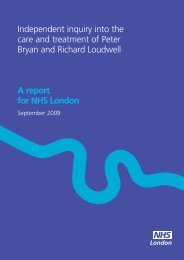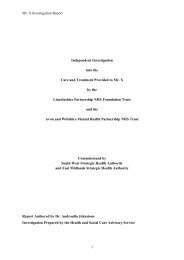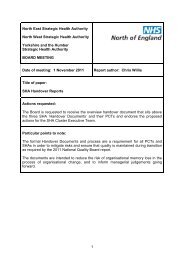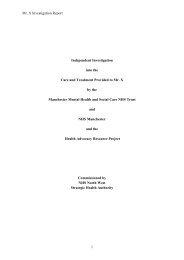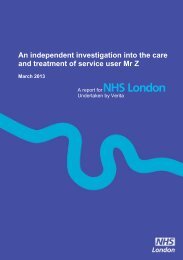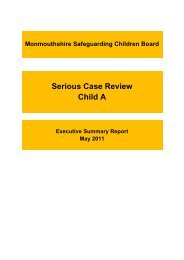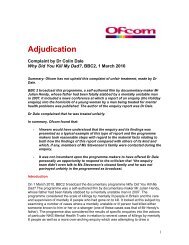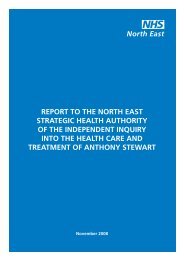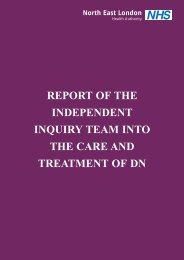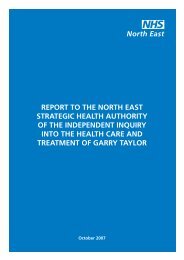Lousia Ovington independent investigation report ... - NHS North East
Lousia Ovington independent investigation report ... - NHS North East
Lousia Ovington independent investigation report ... - NHS North East
You also want an ePaper? Increase the reach of your titles
YUMPU automatically turns print PDFs into web optimized ePapers that Google loves.
CHAPTER 5 – INVOLVEMENT WITH POLICE AND PROBATION<br />
104<br />
communication and no officers with responsibility to liaise with Mental health services.<br />
Again, the panel was told that this would have been done through the MAPPA<br />
process had MAPPA been invoked.<br />
The Mental Health Act provides a mechanism under Section 136 where the police can<br />
forcibly remove and take a person to a place of safety. This was done at least once, on<br />
22 September 2004. After the hospital refused to admit Louisa <strong>Ovington</strong> the police<br />
were required to remove her from the building. The panel was told that the police<br />
being ‘open 24 hours a day’ are the agency that that is used where other agencies are<br />
unable to deal with people.<br />
The issue of medical confidentiality was problematic. DS1’s view was that when a<br />
person gives information to a medical professional indicating the possibility of risk<br />
to another there should be some forum where that information can be shared or<br />
discussed without fear of breach of confidentiality. He told the panel that the doctor<br />
should be able to discuss this ‘in the round’ with other professionals to decide<br />
whether the protection of the public should outweigh patient confidentiality. The<br />
panel agrees that medical confidentiality can present an obstacle, but notes that<br />
MAPPA would have been an appropriate forum for such discussions.<br />
The panel asked DS1 whether in retrospect he felt that the police had regarded Louisa<br />
<strong>Ovington</strong>’s behaviour as commonplace for the area and therefore taken them less<br />
seriously. He denied this, saying that having looked at her offences they were not<br />
commonplace and although some offences committed in the area were alcohol and<br />
drug related, Louisa <strong>Ovington</strong>’s behaviour was beyond the norm.<br />
There was considerable evidence of domestic violence in the relationship between<br />
Louisa <strong>Ovington</strong> and Mr Hilton. The police view was that Mr Hilton was quite placid<br />
and that he was the victim of far more violence from Louisa <strong>Ovington</strong> than she was<br />
from him. DS1 confirmed that the domestic homicide review had noted: “Due to the<br />
high level of contact there is a possibility that some agencies experienced drift and<br />
became complacent and accepting of the levels of violence in this relationship.” DS1<br />
confirmed that it is possible for the police to become ‘case-hardened’.<br />
COMMENT<br />
Louisa <strong>Ovington</strong> was well known to the police and at times came into contact with<br />
them on an almost daily basis. The police were aware that she had involvement with<br />
the mental health and social care services, as well as with probation. The domestic<br />
homicide review noted that there were ten incidents in which the police were involved<br />
that should have triggered referrals to other agencies. There were only in fact two<br />
referrals, both in 2004 and both led to further <strong>investigation</strong> by the mental health



